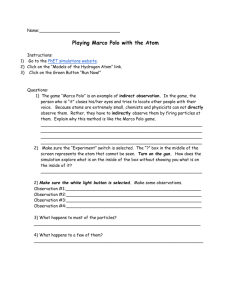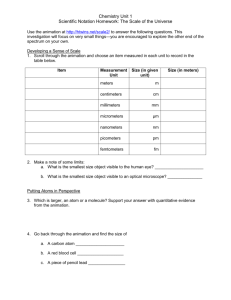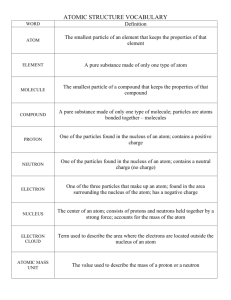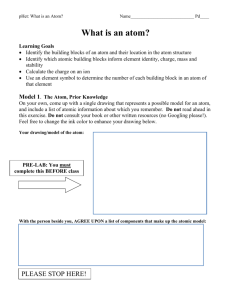DUNHAM-What-is-an-atom-FULL
advertisement
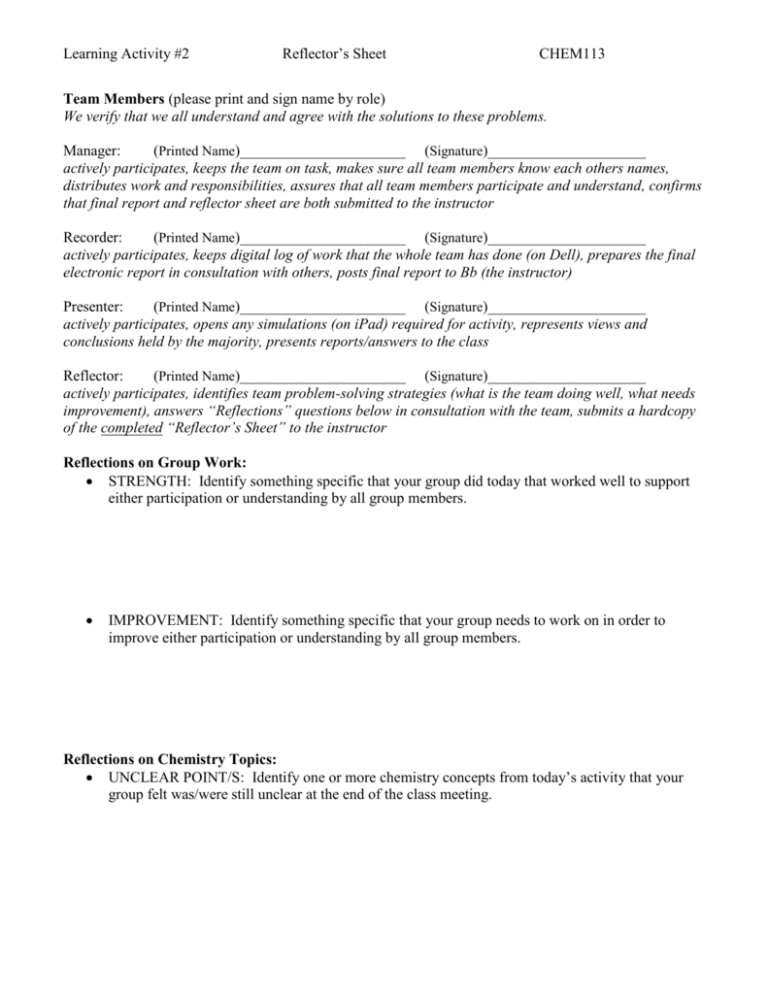
Learning Activity #2 Reflector’s Sheet CHEM113 Team Members (please print and sign name by role) We verify that we all understand and agree with the solutions to these problems. Manager: (Printed Name)______________________ (Signature)_____________________ actively participates, keeps the team on task, makes sure all team members know each others names, distributes work and responsibilities, assures that all team members participate and understand, confirms that final report and reflector sheet are both submitted to the instructor Recorder: (Printed Name)______________________ (Signature)_____________________ actively participates, keeps digital log of work that the whole team has done (on Dell), prepares the final electronic report in consultation with others, posts final report to Bb (the instructor) Presenter: (Printed Name)______________________ (Signature)_____________________ actively participates, opens any simulations (on iPad) required for activity, represents views and conclusions held by the majority, presents reports/answers to the class Reflector: (Printed Name)______________________ (Signature)_____________________ actively participates, identifies team problem-solving strategies (what is the team doing well, what needs improvement), answers “Reflections” questions below in consultation with the team, submits a hardcopy of the completed “Reflector’s Sheet” to the instructor Reflections on Group Work: STRENGTH: Identify something specific that your group did today that worked well to support either participation or understanding by all group members. IMPROVEMENT: Identify something specific that your group needs to work on in order to improve either participation or understanding by all group members. Reflections on Chemistry Topics: UNCLEAR POINT/S: Identify one or more chemistry concepts from today’s activity that your group felt was/were still unclear at the end of the class meeting. CHEM113B F’14 Learning Activity #2 What is an atom? Learning Goals Identify the building blocks of an atom and their location in the atom structure Identify which atomic building blocks inform element identity, charge, mass and stability Calculate the charge on an ion Use an element symbol to determine the number of each building block in an atom of that element Model 1. The Atom, Prior Knowledge As a group, come up with a single drawing that represents a possible model for an atom, and include a list of atomic information about which you are all in agreement. Do not read ahead in this exercise. Do not consult your book or other written resources (no Googling please!). Feel free to change the ink color to enhance your drawing below. Group drawing/model of the atom: Group list of AGREED UPON components of atomic model: PLEASE STOP HERE! Written by Shari Dunham and Stephen Dunham Moravian College, 2014 Learning Activity #2 CHEM113B F’14 Model 2. Have the presenter in your group open the “Atom” mode of the Build an Atom! PhET simulation on an iPad (the link is also posted to the course BlackBoard site). Spend a few minutes exploring the model (feel free to play a bit!) and then, as a group, agree upon answers to the following questions: Key Questions 1. What different kinds of “particles” do you have as building materials for an atom? a) b) c) 2. Are you limited as to where you can put any of these “particles”? If so, briefly describe any limitations in the space below. 3. Which particle/particles affect the element name of the atom you build? 4. Based on Model 2, what do all oxygen atoms have in common? 5. Which particle/particles are responsible for the mass of the atom you build? Provide examples from the Model 2 as evidence to support your answer. 6. How many different uncharged (neutral) stable hydrogen atoms can you build?____ In the space below, briefly describe the similarities and differences in their composition. Written by Shari Dunham and Stephen Dunham Moravian College, 2014 CHEM113B F’14 Learning Activity #2 7. Use the simulation in “Symbol” mode to (a) compete the first row of the table below, and then to (b) build stable charged atoms of at least one other element. Record information about each charged atom in the table below. Element Name Symbol #protons #neutrons #electrons Mass Number Net Charge 𝟏 +1 𝟏𝑯 8. Which particle/particles affect the net charge of the atom you build? Justify your answer with data from your table above. 9. In the space below, provide a general expression to clearly describe how to use your knowledge of an atom’s composition to determine the sign and magnitude of its charge. 10.Considering your group explorations of Model 2 in Key Questions #1-8, would your group propose any changes or adjustments to your drawing in Model 1? Briefly describe any proposed changes or adjustments in the space below: 11.In a single grammatically correct sentence, describe what your group believes is the most important point to remember from this activity. Written by Shari Dunham and Stephen Dunham Moravian College, 2014 Learning Activity #2 CHEM113B F’14 Exercises 56 1. One abundant and stable form of the element iron (Fe) has the symbol 26𝐹𝑒 a) What do all iron atoms and ions have in common? What information did you use to determine this answer? b) How many electrons are in a charged atom (an ion) of Fe2+ ? What information did you use to determine this answer? 2. In the periodic table, elements are represented by abbreviations in boxes such as the one shown to the right for the element boron. Compare the information given in the periodic table representation of boron (at right) to the symbol of a specific boron atom (in the Model 2 simulation). What information about atomic composition of boron is clearly represented in both? Review Exercises (From Chemistry: The Central Science, 12th ed, by BLBMW): Chapter 2 exercises #19(a&b), #20(b&c), #22, #23, #24, #25, #28, #49 Written by Shari Dunham and Stephen Dunham Moravian College, 2014

